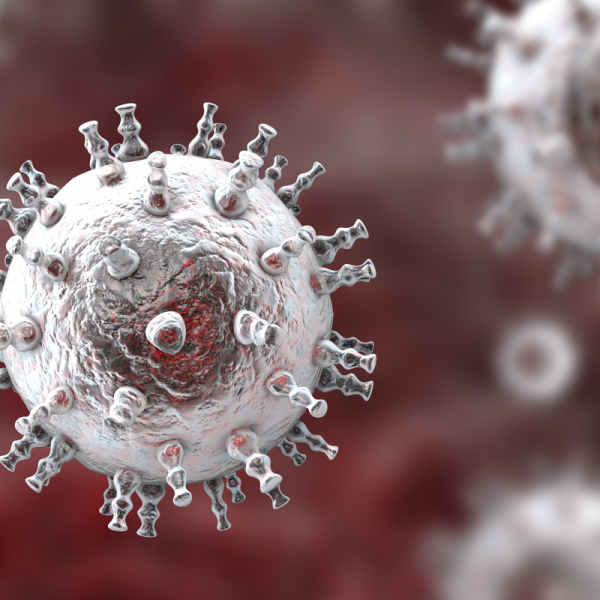
What is Kaposi's sarcoma?
Kaposi's sarcoma is a malignant tumour that usually affects the skin, but can also affect the mucous membranes and internal organs. Sometimes the tumour can occur in several places at the same time and is often favoured by an infection with the human herpes virus 8 (HHV-8). But the cancer can also develop as a result of a weakened immune system. Typically, Kaposi's sarcoma appears in the form of reddish-brown to purple skin patches with possible nodule formation. Depending on the stage, these can expand into extensive plaques or hard nodules.
What are the main forms of Kaposi's sarcoma?
Doctors distinguish between the following four main forms of Kaposi's sarcoma:
- HIV-associated (epidemic) Kaposi's sarcoma: can affect all internal organs as well as the skin and mucous membranes and can quickly take on life-threatening forms. It is either the early sign of an HIV infection or a late symptom as a result of a severely weakened immune system of an AIDS disease.
- Kaposi's sarcoma due to iatrogenic suppression of the immune system: This is the suppression of the immune system caused by medical measures, for example after an organ transplant. Kaposi's sarcoma can regress completely after the end of immunosuppression.
- Classic Kaposi's sarcoma: This not particularly aggressive tumour disease mainly affects older men, mainly of Eastern European or Jewish origin. Typical skin changes develop, especially on the legs, which usually grow slowly over years or decades and almost never affect the internal organs.
- Endemic Kaposi's sarcoma: This disease mainly affects men around the age of 35. Endemic Kaposi's sarcoma occurs particularly frequently south of the Sahara (sub-Saharan region) and again runs in up to four variants. If the endemic Kaposi's sarcoma affects small children, this tumour disease can quickly lead to death due to the infestation of the lymph nodes and intestines.
What symptoms can Kaposi's sarcoma cause?
Initially, Kaposi's sarcoma appears as a single purple, pink or red lump on the skin. This spot can then grow up to several centimetres in size and change colour to blue-purple to black and take on either a flat or slightly raised shape. In some cases, the tumour can also extend deep into the soft tissues and penetrate into the bones. If the tumour is on the mucous membrane, for example in the mouth area, it can take on a blue to purple colour. If, on the other hand, the tumour has already penetrated into the digestive tract, it can cause severe bleeding. Normally, however, the majority of patients remain symptom-free.
What is the typical course of Kaposi's sarcoma?
Kaposi's sarcoma can take very different courses. While in some cases the tissue changes are constant, in other patients they spread in a very short time and can even lead to death, especially in HIV patients.
How is Kaposi's sarcoma diagnosed?
Kaposi's sarcoma can usually be diagnosed by its appearance to the naked eye. In addition, the treating doctor will usually perform a punch biopsy, in which a small piece of skin is removed to be examined under the microscope afterwards. If the patient has HIV, further examinations are usually carried out to check whether the cancer has already spread to other parts of the body. For example, a computer tomography of the chest and/or abdomen may be ordered.
How is Kaposi's sarcoma treated?
So far, there is no generally accepted treatment plan for Kaposi's sarcoma. Rather, there are different treatment options, which always depend on the main form of Kaposi's sarcoma. Accordingly, patients with HIV-associated (epidemic) Kaposi's sarcoma are usually treated with antiretroviral therapy, which aims to suppress the viruses in the body. If the antiretroviral therapy is not sufficient to prevent the spread of Kaposi's sarcoma, chemotherapy can also be considered.
If, on the other hand, the Kaposi's sarcoma is due to iatrogenic suppression of the immune system, it should first be examined whether and to what extent the immune-weakening drugs can possibly be reduced or even completely discontinued. Since the tumour foci usually only developed as a result of these drugs, they usually disappear completely after they are discontinued.
In the case of endemic Kaposi's sarcoma, the doctor will usually administer anti-cancer drugs with which the tumour disease can be well controlled. Classic Kaposi's sarcoma, on the other hand, is usually treated locally with radiotherapy and can possibly be combined with cold therapy (cryotherapy) or chemotherapy.
What is the aftercare of Kaposi's sarcoma?
Since Kaposi's sarcoma has a tendency to recur after successful treatment (recurrences), it is important for patients to have regular check-ups with their doctor.
